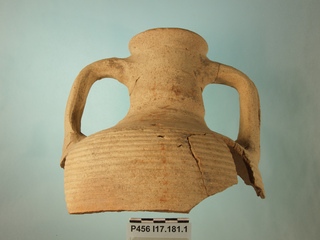

There's a good description of the form on the Digital Amphorae website. Once you click past the annoying interstitial, you can read Paul Reynolds' up to date text. Here's a passage from it:
Sixth century examples (Egoff 164) differ by having a more cylindrical body and a rounded, plain base. The neck is also cylindrical, ending with a marked concave band. Handles are large and thick. The walls are ‘turned’ to create stepped wide flat sections separated by a narrow ridge. This ridge is in fact a spiral from the base to the neck. The same ribbing is found on later fifth century AD examples, but is not stepped. Narrow convex ribbing is characteristic of shoulder and base sections of fifth century AD and some early sixth century AD examples.The Ilion example comes from the deposits we associate with an early sixth century earthquake but doesn't yet have the 'stepped wide sections'. A date sometime in the later fifth century or early sixth fits this vessel well.
FYI, the British Museum has an LRA1 with wide stepped flat sections. Click on 'Larger image' for useful detail.
Regarding that Digital Amphorae insterstitial, read this from Tom Elliott.

No comments:
Post a Comment